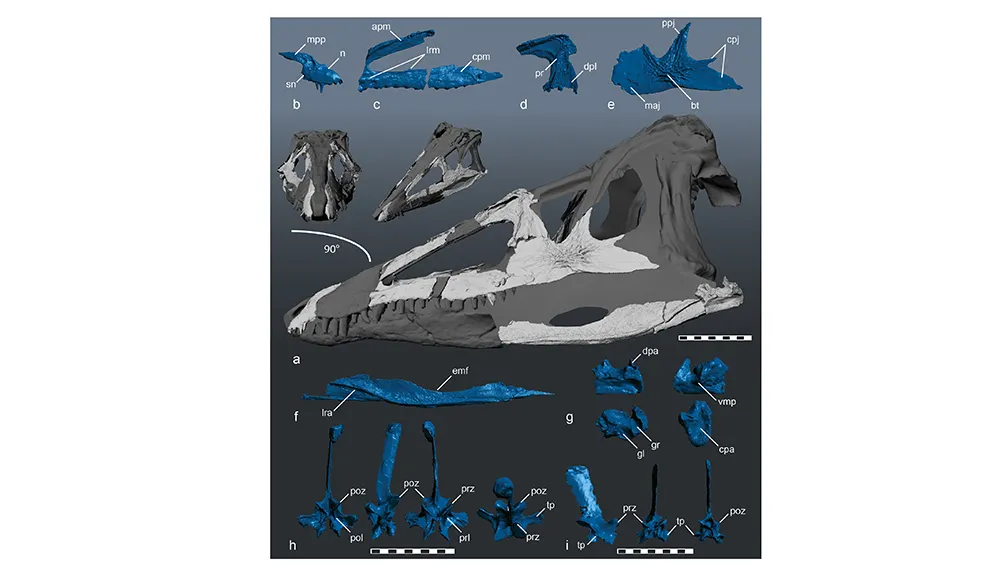Before There Were Crocodiles, There Was the “Carolina Butcher”
A newly discovered crocodilian ancestor was a nine-foot-tall predator that stood on its hind legs
:focal(1845x1001:1846x1002)/https://tf-cmsv2-smithsonianmag-media.s3.amazonaws.com/filer/82/97/8297e3c5-a6fa-4d7d-b866-1a14d93533d1/88464.jpg)
The reptilian killer stalked through the tropical mud, a nine-foot-tall predator in search of its next victims. The bizarre beast walked on two hind legs, and its powerful jaws could crunch through small mammals and armored reptiles alike. This was Carnufex carolinensi, also called the “Carolina Butcher.”
Today the American crocodile is considered a “gentle fish-eater.” But this newfound ancestor of the modern croc had anything but a docile temperament, according to a study by paleontologists at North Carolina State University and the North Carolina Museum of Natural Sciences, a Smithsonian Affiliate museum. At about 231 million years old, the newly described species offers fresh insight into crocodile evolution and behavior in the days before the reign of the dinosaurs.
To reconstruct the ancient killer, the team examined many pieces of a single Carnufex skeleton, including parts of the skull, spine and upper forelimb. The fossils were found in the Pekin Formation, a geologic area in Chatham County, North Carolina, that holds sediment from the Late Triassic period, when what is now North Carolina was a warm equatorial region just starting to break away from the supercontinent Pangea. Right from the start, the scientists could tell that these bones belonged to a different sort of animal, says study leader Lindsay Zanno.
“Even before we had prepared the bones from the rock, we knew we had a unique and bizarre new species,” she says. “The skull of Carnufex is highly ornamented with bumps and grooves, unlike anything we had seen before. After removing all the bones, we were excited to discover that this animal is a bit of a Frankenstein,” adds Zanno, whose team describes the odd animal this week in the journal Scientific Reports.
“We were a little perplexed,” says Susan Drymala, a graduate student and co-author. “It wasn't immediately clear what kind of animal this was—it was big and the bones had a number of features totally unique to it.”

Zanno describes the new species as a blend of other crocodile ancestors, or crocodylomorphs mixed with another Triassic predator group called the rauisuchids, with “a couple predatory dinosaur traits thrown in for good measure.” After analyzing all the individual bones with a high-resolution surface scanner, the team was able to create a 3-D model of the animal’s reconstructed skull, which helped confirm its status as a new type of crocodylomorph.
The finding establishes a new perspective on the predator ecosystem of the Triassic, a period when the ancestors of crocodiles and birds first emerged. It also changes the way the lineage of crocodiles is viewed, since Carnufex is much larger in size and with longer hind legs then the shorter limbs of its current crocodilian relatives. The team hypothesizes that Carnufex was among a "panoply of predators” that fought for supremacy in ancient North Carolina, before predatory dinosaurs had made it that far north. Their discovery places crocodile ancestors at a moment in time earlier than they have ever been spotted before.
“It pushes back the date of crocodylomorphs in the fossil record,” says Daniel Mulcahy, a researcher at the Smithsonian National Museum of Natural History. “And because of its size, presumed diet and body shape, [Carnufex] changes our thinking on what these early crocodiles looked like and what they did.”
At the end of the Triassic about 200 million years ago, Carnufex and many other predators were wiped out during one of the top-five biggest extinctions of all time, leaving ample opportunity for dinosaurs to rise up and rule for the next 135 million years. Since then, crocodiles have changed significantly, adapting for survival. “They took on a role similar to foxes or jackals, with small, sleek bodies and long limbs," says Drymala. Ultimately, Carnufex demonstrates just how much this particular group evolved.
“Crocodylomorphs are too often tagged with the 'living fossil' label—they haven't changed since the days of the dinosaurs,” notes University of Iowa professor Chris Brochu. “This is simply untrue, as Carnufex shows dramatically.”
/https://tf-cmsv2-smithsonianmag-media.s3.amazonaws.com/accounts/headshot/profile.jpg)
/https://tf-cmsv2-smithsonianmag-media.s3.amazonaws.com/accounts/headshot/profile.jpg)